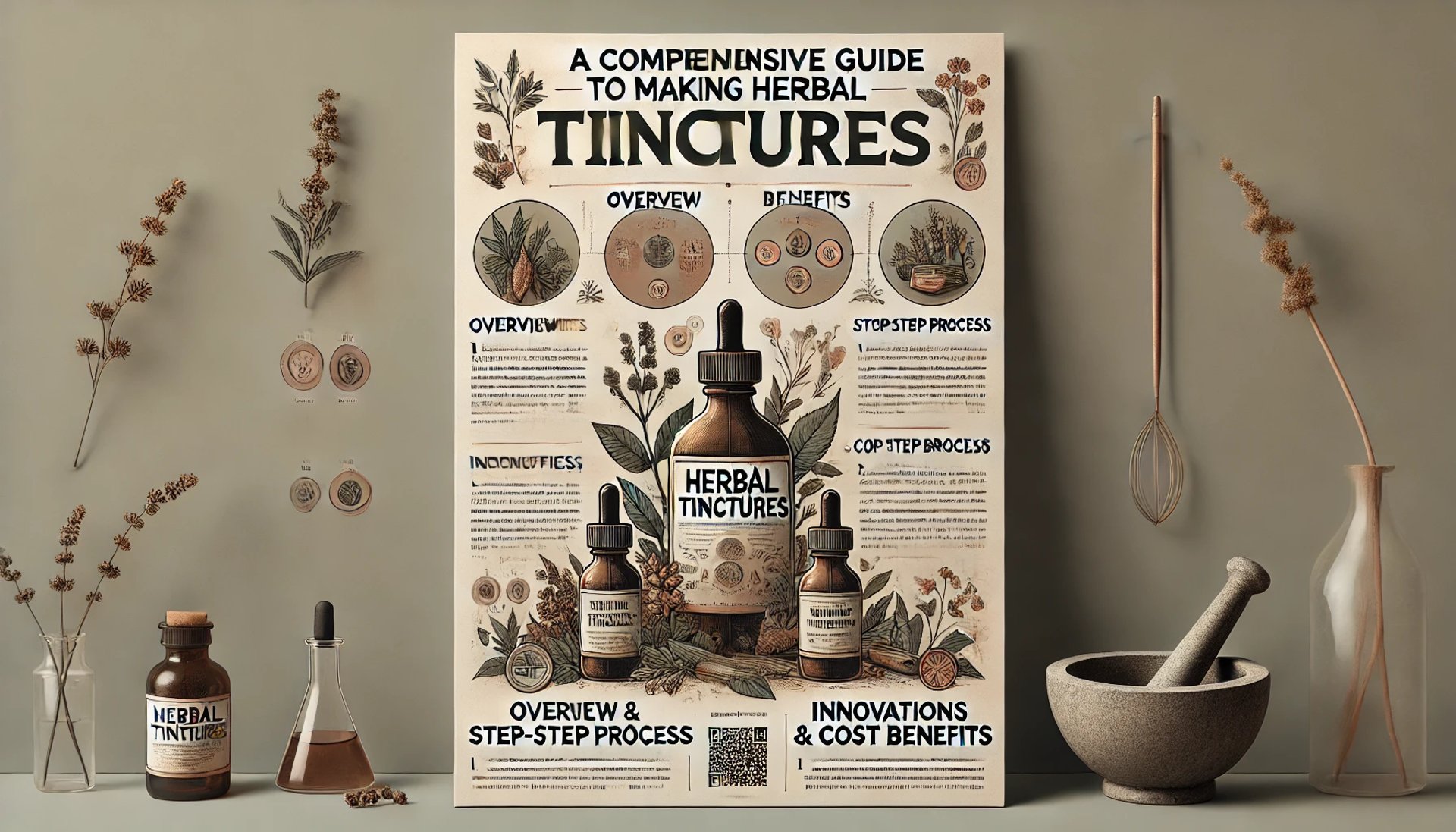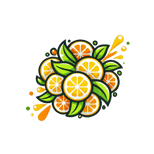
Herbal Tinctures
A Guide for making Tinctures at home
Tinctures, concentrated herbal extracts made by soaking plant material in alcohol or other solvents, have been used for thousands of years across various cultures. Their history is deeply interwoven with medicine, alchemy, and herbalism, dating back to ancient civilizations.
Ancient Civilizations
The earliest known use of tinctures can be traced back to ancient Egypt, around 1500 BCE. Egyptian medical texts, such as the Ebers Papyrus, mention herbal infusions and alcoholic extractions used to treat ailments. The Egyptians were skilled in extracting the medicinal properties of plants using wine and other fermented liquids.
Similarly, in ancient China, tincture-like preparations were used in traditional medicine. The Shennong Bencao Jing, one of the oldest Chinese pharmacological texts (believed to have been compiled between 300 BCE and 200 CE), describes methods of extracting plant essences using alcohol. The Taoists, known for their pursuit of longevity and alchemy, also developed tinctures with medicinal and spiritual significance.
The Greco-Roman Era
Greek physicians, including Hippocrates (460–370 BCE) and Dioscorides (circa 40–90 CE), wrote extensively about plant-based medicines. Dioscorides’ "De Materia Medica" detailed various herbal preparations, some of which involved alcohol as a solvent. The Romans, influenced by Greek medical knowledge, adopted similar practices, using wine-based extractions for medicinal purposes.
The Middle Ages
During the Middle Ages (5th to 15th century), European monks and alchemists refined the art of tincture-making. Monasteries served as centers of knowledge, where monks studied ancient medical texts and experimented with herbal remedies. The development of distillation techniques in the Islamic world, particularly by Persian polymath Avicenna (980–1037 CE), played a crucial role in advancing tincture production. His works influenced European alchemists, who further developed alcohol-based extractions.
Alchemy, which thrived during this period, contributed to the understanding of plant extractions. Paracelsus (1493–1541), a Swiss physician and alchemist, is often credited with popularizing the use of tinctures in medicine. He emphasized the importance of using alcohol to extract and preserve the active compounds of medicinal plants, laying the foundation for modern tincture-making.
The Renaissance and Early Modern Period
The Renaissance (14th–17th century) saw a revival of classical knowledge, including herbal medicine. With the advent of the printing press, medical texts became widely available, spreading knowledge about tinctures. Apothecaries and herbalists across Europe began producing tinctures on a larger scale. By the 17th and 18th centuries, tinctures became a staple in medical practice, particularly in Western herbal medicine.
The 19th and 20th Centuries
During the 19th century, advancements in chemistry and pharmacology led to more precise methods of extracting and standardizing herbal medicines. The use of tinctures became widespread in both folk and professional medicine. However, with the rise of synthetic drugs in the 20th century, the popularity of tinctures declined.
Modern Revival
Today, tinctures are experiencing a resurgence due to the growing interest in natural and holistic health. Herbalists, naturopaths, and wellness enthusiasts appreciate their potency, ease of use, and long shelf life, continuing a tradition that spans thousands of years.
Advantages of Tinctures Over Other Methods
Concentration and Potency:
Tinctures provide a concentrated form of herbal medicine. A few drops can deliver an effective dose, compared to teas or infusions that require larger quantities and are subject to degradation when exposed to water-soluble constituents.Extended Shelf Life:
Alcohol-based tinctures can remain stable and potent for up to 3–5 years when stored properly, whereas water-based infusions have a much shorter lifespan.Versatility in Administration:
Tinctures can be taken directly, diluted in water, added to teas, or even used in culinary applications. This flexibility makes them suitable for various therapeutic needs and lifestyle preferences.Efficient Extraction:
The use of alcohol ensures that a wide range of active compounds is extracted from the herb, including essential oils and alkaloids that might not be efficiently extracted by water alone.
Solvent Options: Alcohol Versus Apple Cider Vinegar
Alcohol-Based Tinctures
Alcohol (typically vodka or whisky with 80–100 proof) is considered the ideal solvent for tincture making due to its superior extraction capabilities. The high ethanol content not only extracts a broad spectrum of compounds but also acts as a preservative, contributing to the long shelf life of the tincture.
Apple Cider Vinegar (ACV) as an Alternative
For individuals who are sensitive or allergic to alcohol, apple cider vinegar (ACV) offers an alternative solvent. However, there are important considerations:
Extraction Efficiency: ACV is less effective at extracting certain compounds compared to alcohol.
Shelf Life: Tinctures made with ACV typically have a shorter shelf life.
Milder Effects: The potency of the final product may be reduced, and adjustments in dosage may be necessary.
When using ACV, it is important to maintain similar herb-to-solvent ratios and to monitor the tincture’s efficacy over time.
Incorporating Colloidal Elements: An Emerging Trend
Recent trends in herbal medicine have seen the incorporation of colloidal elements—such as copper, silver, or gold—into tinctures. These elements are suspended as minute particles in a liquid, offering additional antimicrobial, anti-inflammatory, and immunomodulatory benefits.
Colloidal Silver: Known for its broad-spectrum antibacterial and antiviral properties.
Colloidal Copper: Supports collagen synthesis and skin health, potentially enhancing wound healing.
Colloidal Gold: Though less common, it is believed to improve mental clarity and reduce inflammation.
When integrating colloidal elements into tinctures, it is advisable to add them in minimal quantities. Typically, 10–20 drops per 8 ounces of tincture is sufficient.
Essential Equipment and Ingredients
Equipment List
Glass Jar with a Tight-Fitting Lid: A sterilized mason jar or similar container is required for the maceration process.
Fine Mesh Strainer or Cheesecloth: For separating the liquid extract from the herbal matter after steeping.
Dark Glass Dropper Bottles: Protect the tincture from light exposure and facilitate accurate dosing.
Measuring Cups and Spoons: Ensure precise measurement of herbs and solvents.
Funnel: Assists in transferring the tincture into storage bottles.
Labels and Permanent Marker: Critical for tracking ingredients, solvent type, and preparation date.
Ingredients List
Herbs: Select medicinal herbs based on desired therapeutic outcomes. Common examples include:
Echinacea: Immune system support
Chamomile: Digestive comfort and relaxation
Lavender: Calming effects and mild sedative properties
Peppermint: Aids in digestion and alleviates nausea
Ginger: Anti-inflammatory and warming properties
Solvents:
Alcohol: 80–100 proof vodka or whisky for optimal extraction and preservation
Apple Cider Vinegar: For those who prefer an alcohol-free option
Optional Additives:
Colloidal Copper, Silver, or Gold: 10–20 drops per 8 ounces of tincture as an enhancing additive
Filtered Water: May be used for dilution or in combination with other solvents if needed
Detailed Tincture Preparation Process
The preparation of tinctures involves several systematic steps that ensure maximum extraction of the herbal compounds while maintaining the integrity of the final product.
Step 1: Herb Preparation
Drying or Using Fresh Herbs:
For dried herbs, use a ratio of 1 part herb to 5 parts alcohol by volume.
For fresh herbs, the ratio is typically 1 part herb to 2 parts alcohol.
Chopping or Crushing:
Lightly crush or chop the herbs to increase surface area, which improves the extraction efficiency of the solvent.
Step 2: Combining Herbs and Solvent
Placing Herbs in the Jar:
Place the prepared herbs into a clean, sterilized glass jar.Adding the Solvent:
Pour the chosen solvent (alcohol or ACV) over the herbs until they are completely submerged. Ensure a small margin of liquid above the herbs to account for expansion and air exposure.Incorporating Colloidal Elements:
If adding colloidal elements, introduce 10–20 drops per 8 ounces of tincture at this stage, ensuring even distribution.
Step 3: Maceration and Infusion
Sealing and Labeling:
Securely seal the jar and label it with the herb name(s), solvent type, and the preparation date.Storage Conditions:
Place the jar in a cool, dark location (e.g., a cupboard) to avoid light and heat, which can degrade the tincture’s quality.Duration:
Allow the mixture to steep for 4 to 6 weeks. During this period, shake the jar gently once a day to mix the contents and promote thorough extraction.
Step 4: Filtration and Bottling
Straining the Mixture:
After the infusion period, strain the liquid through a fine mesh strainer or cheesecloth. Squeeze out any remaining liquid from the herb mass to ensure maximum yield.Transferring to Storage Bottles:
Use a funnel to transfer the strained tincture into dark glass dropper bottles, which help protect the contents from light degradation.Final Labeling:
Clearly mark each bottle with the herb used, the solvent, the date of bottling, and any additives included.
Herb Selection and Therapeutic Uses
Local and commonly available herbs offer a wide range of applications when prepared as tinctures. Here are a few examples:
Echinacea:
Used to support the immune system, especially during the cold and flu season. An echinacea tincture is valued for its antimicrobial and anti-inflammatory properties.Chamomile:
Known for its calming effects, chamomile tincture is effective for soothing the digestive tract and alleviating mild anxiety.Lavender:
Employed as a mild sedative, a lavender tincture can help reduce stress and promote restful sleep.Peppermint:
Utilized for its digestive benefits, peppermint tincture can relieve nausea and support overall gastrointestinal health.Ginger:
With strong anti-inflammatory properties, a ginger tincture is often used to alleviate joint pain and improve circulation.
Each of these herbs is widely available and can often be sourced locally, making them accessible for both personal use and small-scale production.
Health and Cost Benefits of Home-Made Tinctures
Creating tinctures at home not only allows for customization and quality control but also presents significant health and economic advantages:
Quality Control:
Home preparation ensures that you can select organic, non-GMO herbs and high-quality solvents, reducing exposure to unnecessary additives or contaminants.Cost Efficiency:
The ingredients required for tincture production are relatively inexpensive, especially when compared to commercial supplements. Local sourcing further reduces costs.Therapeutic Efficacy:
Tinctures offer a high concentration of active compounds in a small volume, allowing for precise dosing and rapid absorption.Self-Sufficiency:
Learning to make tinctures can empower individuals to take charge of their health by relying on natural remedies that are both effective and sustainable.
Storage and Shelf Life Considerations
Proper storage is crucial for maintaining the potency and efficacy of your tinctures:
Light Protection:
Always store tinctures in dark glass bottles to minimize light exposure, which can degrade the herbal compounds.Temperature:
Keep tinctures in a cool, dark place. Alcohol-based tinctures are relatively stable and can last 3–5 years, while ACV-based tinctures should be used within approximately one year.Labeling:
Ensure that each bottle is labeled with the date of preparation. This practice helps track the age of the tincture and informs you when it may be nearing the end of its optimal potency.
Modern Enhancements: Colloidal Elements
The integration of colloidal copper, silver, or gold into herbal tinctures is a developing trend that combines traditional herbal practices with modern nanotechnology. These colloidal elements are believed to:
Enhance the antimicrobial properties of the tincture.
Support skin health and wound healing (colloidal copper).
Provide additional immune support (colloidal silver).
Improve cognitive functions and reduce inflammation (colloidal gold).
Conclusion
Herbal tinctures represent a convergence of time-tested tradition and modern science. Their superior extraction properties, long shelf life, and versatility in administration make them an excellent choice for those seeking natural health solutions. By following a standardized preparation process—ensuring careful measurement, proper equipment use, and mindful storage—individuals can produce high-quality tinctures that not only support health but also offer economic advantages over commercial alternatives.
Whether you opt for an alcohol-based tincture to maximize extraction efficiency or choose apple cider vinegar as a gentler alternative, the process remains fundamentally the same. Incorporating optional additives like colloidal elements can further enhance the therapeutic benefits, offering an innovative twist on an ancient practice.
Zestify
Joie de vivre
Contact
© 2025. Tous droits réservés.
Ce site a été construit avec
Cliquez ici pour 20 % réduction


